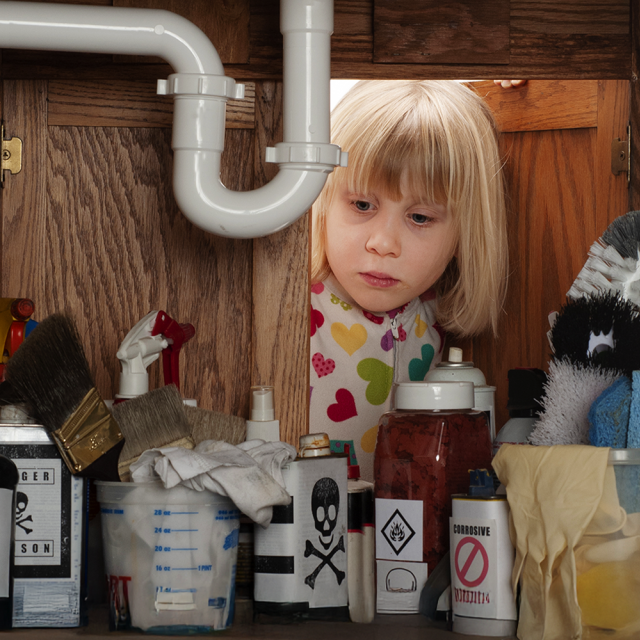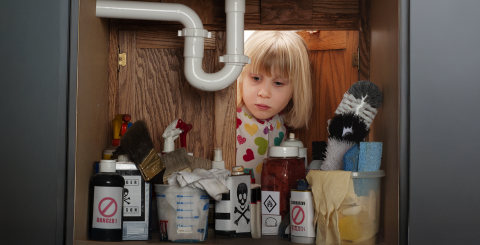How to prevent water damage: be careful with the products under your sink

Do you usually store your household cleaning products under the bathroom or kitchen sink? Did you know that these products contain corrosive ingredients that can cause plumbing leaks and water damage? Water damage is the leading cause of home insurance claims in Québec, even though it can be prevented by taking a few simple precautions.
Here’s a bite-sized read where you’ll learn why you shouldn’t store cleaning products under a sink, and then how to respond in the event of water damage. Because being well prepared means being better protected!
Why should you avoid storing household cleaning products under the sink?
It makes sense to store cleaning products where you use them most, so they’re within easy reach in the kitchen or bathroom. That’s normal! That’s why you usually store them in the cabinet under the sink. However, many products can, without your knowledge, corrode the pipes that run through them and slowly but surely cause water damage.
It’s important to note that polymer (plastic) pipes and nuts tend to degrade when exposed to chemicals. This is an insidious process whose consequences only become apparent years later, during renovations, for example. Even stainless steel pipes can be affected by particularly corrosive cleaning products that are commonly used. The resulting problems are numerous: water damage, leaks, mould, and increased insurance premiums in the event of a claim.
So how can you quickly detect these problems, or even prevent them?
Tips on household cleaning products
It is strongly recommended that you store your cleaning products in a safe, well-ventilated area away from light, out of the reach of children, and away from pipes, especially if these products contain chlorine. You are also encouraged to regularly inspect pipes and faucets (sink, shower, bath, toilet, kitchen sink) with a flashlight to check for rust (a sign of corrosion) and with your hand to see if any pieces are likely to come loose. If you must use corrosive products in a sink, rinse the pipes thoroughly after use to prevent deposits from forming.
You can also opt for non-corrosive cleaning products the next time you go shopping. For example, look for products that are Ecocert certified and labelled as biodegradable and free of artificial fragrances.
Lastly, make sure your bathroom is well ventilated and that there is no sign of mould or accumulation of water (at the bottom of the bathtub or shower). You can also have a leak detection system installed in strategic locations, such as in the kitchen, near the sink or dishwasher, in the bathroom, and next to the washing machine. Installing such a system with a water shutoff valve could even lower your insurance premium by limiting the risk of possible claims over time and, at the same time, the risk of potential claims!
What to do in case of water damage
Did you know? In the event of a disaster, you have an obligation to limit the damage to your property. Check out these five steps to be ready to respond and protect your possessions and home as best you can, despite the urgency of the situation!
Step 1: Depending on the damage, immediately call the appropriate authorities (fire department, police, or plumber).
Step 2: Limit the damage right away whenever possible! You must get the situation under control so that the damage doesn’t get worse, until your insurer informs you of its response—after you call them in Step 3!
Step 3: Contact your insurer to report your claim and the damage observed as soon as possible. Be transparent to ensure that your claim is handled quickly and efficiently.
Good to know: To make it easier to follow up on your claim, note the date and the name of the person you spoke to when you called your insurer.
Step 4: Authorize any emergency work necessary to prevent further damage, such as professional cleaning in the event of sewage damage. Keep all invoices and correspondence (emails, estimates, etc.) as proof.
While waiting for specialized companies to arrive, here are some steps you can take:
- Shut off the water supply.
- Unplug electrical appliances.
- Raise your belongings off the floor.
- Ventilate the room.
- Dry the walls to prevent mould.
Step 5: If you need to take further action, talk to your insurer first to make sure it’s covered by your insurance policy. Also, if you wish to dispose of damaged items or furniture, take photos and write a description of them so that you can include them in your claim.
Why is it so important to call your insurer?
Regardless of the size of the disaster, remember that you are required to report it to your insurer as soon as it occurs or as soon as you become aware of it. If you don’t do it promptly, you could lose your right to be compensated for this or future claims.
Water damage is a nightmare for everyone. It’s best to take all the necessary steps to prevent it as much as possible! But if the worst happens, rest assured that you can count on a trusted insurer to help you!
For more tips on water damage and other topics related to protecting your home, visit our blog page.
To learn more about home insurance, contact a Promutuel Insurance damage insurance representative today, or get an online quote from Promutuel Insurance in just four minutes!




